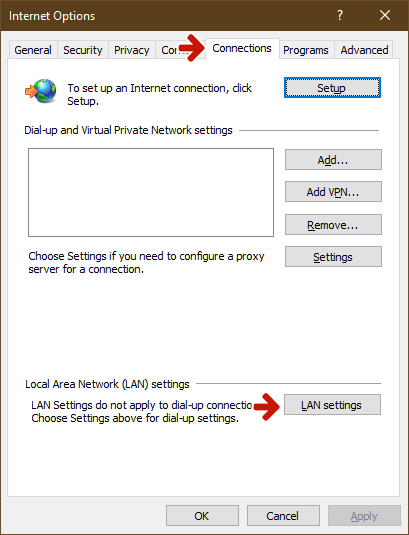Proxy
How to configure a Proxy server
Setting the proxy server in this browser affects the rest of the Windows operating system. For example, other installed browsers like Google Chrome and Opera use Internet Explorer's proxy settings. In Windows 10 and Windows 8.1, modern apps connecting to the internet use the same settings, and so on.

Start Internet Explorer and go to Tools Alt+X. Then, click Internet options.

The Internet Options window is opened. Here, go to the Connections tab and click the LAN settings button on the bottom.

The Local Area Network (LAN) Settings window is opened.

Check the box that says Use a proxy server for your LAN. Then, in the Address field below, type the proxy address. In the Port field, type the port that is used by the proxy server. If you are in a business network, you might want to check the box that says Bypass proxy server for local address so that the proxy is not used when accessing websites and services from your network and only when accessing the internet. When done setting things up, click OK in the Local Area Network (LAN) Settings window and then in the Internet Options window.
Google Chrome does not offer any unique configuration options for setting a proxy server because it uses the proxy settings found in Internet Explorer or Windows. However, you can start the setup process from Google Chrome, and it opens the Internet Options window from Windows.

Start Google Chrome and open Settings.

Сlick on the link that says Advanced, System. Click Open proxy settings.

The Internet Options window is opened. Here, go to the Connections tab and click the LAN settings button on the bottom.

The Local Area Network (LAN) Settings window is opened.

Check the box that says Use a proxy server for your LAN. Then, in the Address field below, type the proxy address. In the Port field, type the port that is used by the proxy server. If you are in a business network, you might want to check the box that says Bypass proxy server for local address so that the proxy is not used when accessing websites and services from your network and only when accessing the internet. When done setting things up, click OK in the Local Area Network (LAN) Settings window and then in the Internet Options window.
Opera does not offer any unique configuration options for setting a proxy server because it uses the proxy settings found in Internet Explorer or Windows. However, you can start the setup process from Opera, and it opens the Internet Options window from Windows.

Start Opera and open Settings.

Сlick on the link that says Advanced, System. Click Open proxy settings.

The Internet Options window is opened. Here, go to the Connections tab and click the LAN settings button on the bottom.

The Local Area Network (LAN) Settings window is opened.

Check the box that says Use a proxy server for your LAN. Then, in the Address field below, type the proxy address. In the Port field, type the port that is used by the proxy server. If you are in a business network, you might want to check the box that says Bypass proxy server for local address so that the proxy is not used when accessing websites and services from your network and only when accessing the internet. When done setting things up, click OK in the Local Area Network (LAN) Settings window and then in the Internet Options window.
By default Mozilla Firefox uses the same proxy settings as set in Internet Explorer. If you wish to explicitly set the proxy server in Firefox then follow the steps below.

Start Mozilla Firefox and open Options.

Сlick on the link that says General and scroll down to Network Settings.
Сlick the Settings... button on right.

Connection Settings window is opened.

Check the box that says Manual proxy configuration and fill proxy address and port.



 English
English Česky
Česky Русский
Русский Українська
Українська